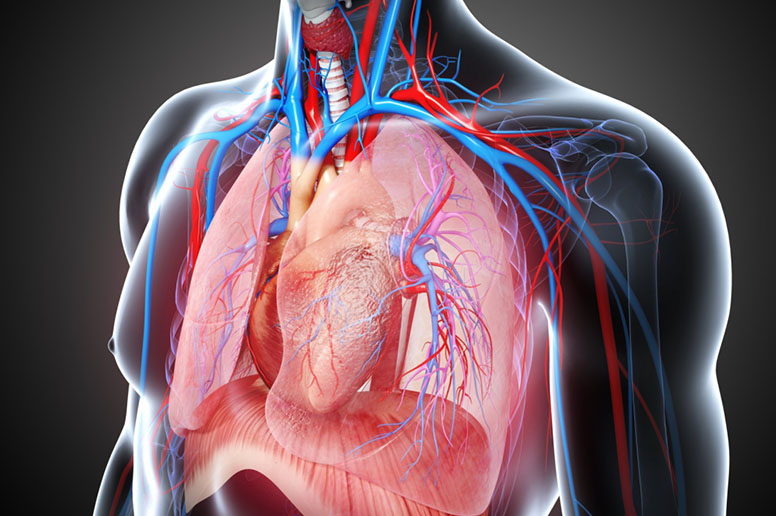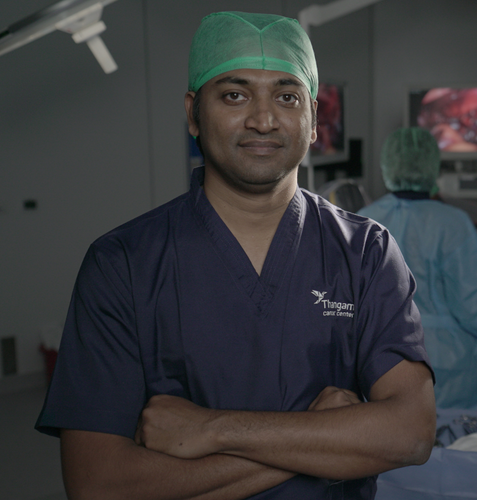Thoracic Surgery in India
The lungs, oesophagus, and other organs in the chest cavity are all included in the scope of thoracic surgery, a subspecialty of surgery. Patients undergoing thoracic surgery in India have access to cutting-edge medical resources and highly skilled surgeons who are skilled in minimally invasive and robotic-assisted treatments.
We provide thorough treatment options for thoracic cancers, such as lung cancer, esophageal cancer, and mediastinal tumours, at Thangam Robotic Institute. Our team of specialists offers patients individualised care and efficient treatment choices by utilising the most recent technology and methods.
Thangam Robotic Institute is a reputable location for thoracic surgery in India because of our dedication to high-quality care and patient safety.

What is robotic surgical procedure?
A form of minimally invasive surgery called robotic thoracic surgery in India is employed in thoracic treatments for select types of lung cancer. Damaged lung tissue and perhaps nearby lymph nodes can be removed using this method. It is also referred to as thoracic surgery with robotic assistance.
In robotic surgery, the surgeon will operate the robotic surgical system's tools while seated at a console adjacent to the patient in the operating room. To offer a view of the interior of the chest cavity, a small 3D high-definition camera is first inserted into one of the cuts (incisions). The other little incisions created between the ribs are then used to insert robotic devices. The doctor's hands at the console have complete control over the robotic devices. The doctor removes lung tissue through one of the incisions. Without having to make larger incisions to open the chest or split the ribs, the surgeon can remove lung tissue with fine, controlled movements thanks to the magnified vision and wristed equipment. In addition to lung cancer surgery, the robotic approach can be utilised for additional chest procedures including the lungs, oesophagus, thymus, and several heart procedures.
Key Benefits:
- The robotic tools may be controlled and are precise. The camera also enables the surgeon to see the chest clearly during surgery and to reach areas of the chest that can be challenging to access.
- Less blood loss, faster recovery times, and fewer complications may result from minimally invasive surgery.

SARAVANA RAJAMANICKAM, M.D., MS., MCH.,
Founder
Surgeon Specialising in Lung & Esophageal Cancer
Dr. Saravana Rajamanickam is an authority in the field of thoracic oncology and specialises in the treatment of mediastinal tumours, lung cancer, and esophageal cancer. Oncology is a somewhat uncommon field, and most parts of the nation have few experts in it. In order to lessen the discomfort and difficulties associated with treating such tumours, he is particularly interested in performing surgeries using "Minimally Invasive" techniques and cutting-edge technologies, including robotics. He is engaged in research to develop new lung cancer treatment plans in addition to his clinical activities.
Read MoreConditions Treated
Robotic Lung Lobectomy
The removal of a lung lobe during surgery is known as a lobectomy. In the case of early-stage lung cancer, it is done to remove a section of the diseased lung. A lobectomy can help cure conditions like a fungal infection, emphysema, and tuberculosis in addition to cancer.
Robotic Sleeve Lobectomy
A sleeve lobectomy involves removing the affected lobe along with a portion of the main stem bronchus. On the primary stem bronchus, the remaining lobe (s) are reimplanted. As an alternative to pneumonectomy, this technique is appropriate for lung tumours that are central in location.
Robotic Lung Pneumonectomy
A pneumonectomy is an operation to remove one of your lungs due to cancer, trauma, or another illness.
The best and safest operation to replace a thoracotomy in the treatment of lung cancer is a robotic pneumonectomy. Major bleeding can be avoided with careful practise, and most surgeries are finished robotically.
Robotic Thymectomy
Thymectomy, or the removal of the thymus gland, is most frequently performed on people who have thymoma and myasthenia gravis. Robotic thymectomy is less intrusive and aids in patients' quicker recovery.
Robotic Mediastinal Tumor resection
In thoracic surgery with robot assistance, the surgeon uses tiny robotic arms to do procedures inside the chest but away from the heart. It provides a wider range of mobility than traditional surgery. Rare tumours called mediastinal teratomas frequently develop in the anterior mediastinum. Most of these tumours are slow-growing benign tumours. These tumours are treated surgically by resection due to their minimal malignant potential.
Robotic Esophagectomy
Minimally invasive procedures are being used more frequently while performing esophagectomy for esophageal cancer. Over the past few years, the development of robotic aided minimally invasive esophagectomy (RAMIE), a procedure that is safe, practicable, and has less problems than open surgery, has been made possible by the development of robotic platforms.
Robotic Tracheal resection
A surgical operation called a tracheal resection is used to remove all or a portion of the windpipe. The tube that joins the voice box with the lungs is known as the windpipe. When tracheal stenosis is refractory to conservative therapy, such as balloon dilation and scar excision, tracheal resection is performed. Patients who undergo robot-assisted surgery benefit from flexible equipment and a three-dimensional magnified perspective, which improves accuracy and results.
Robotic trachea-esophageal fistula resection
A tracheoesophageal fistula is an improper communication or connection between the oesophagus, the food pipe, and the trachea, the windpipe. With the aid of a robot, the procedure to disconnect the fistula can now be performed with a high success rate and a quicker recovery.
Robotic Diaphragm Plication
Dyspnoea has a known cause: diaphragm paralysis. Diaphragm paralysis is commonly treated with a diaphragm plication surgery. For diaphragm plication, robot-assisted thoracoscopy is a good minimally invasive substitute for traditional video-assisted thoracoscopy, making the procedure simpler to carry out.
FAQ
-
What kinds of cancers can be treated in India with thoracic surgery?
Lung cancer, oesophageal cancer, and mediastinal tumours can all be treated with thoracic surgery in India.
-
What advantages can thoracic surgeries offer for cancer therapy in India?
Access to contemporary facilities and cutting-edge technology, highly qualified surgeons, and reasonably priced treatment options are just a few advantages of choosing thoracic surgery for cancer treatment in India.
-
What percentage of patients in India who undergo thoracic surgery for cancer recover?
The type and stage of the cancer, the patient's general health, and the surgeon's experience all have an impact on the success rate of thoracic surgery for cancer therapy in India. However, the success rate is high due to the accessibility of cutting-edge facilities and skilled doctors.
-
What is the length of recovery following thoracic surgery in India for cancer treatment?
Depending on the kind and degree of surgery required for cancer treatment in India, different recovery times apply. However, with the right post-operative care, the majority of patients can anticipate complete recovery in a few weeks.
-
Do thoracic surgeries for cancer therapy in India include any risks?
Thoracic surgery for cancer therapy in India entails some dangers, including bleeding, infection, and harm to the organs around the incision. However, the risks are reduced with rigorous pre-operative assessment and skilled surgeons.
